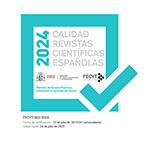New approaches to the propagation of the antifeminist backlash on Twitter
Abstract
A year after the #MeToo movement erupted, antifeminism started to retort. The idea behind the backlash was that ‘the men who have been accused are the heroes’ (Tolentino, 2018). Twitter was one of the public spaces where this confrontation occurred; the #HimToo backlash gathered steam in 2018 (Asimov, 2018) and expanded into 2019. Focussing on the reactions against #Cuéntalo Twitter campaign –the Spanish equivalent to #MeToo—, this article examines how the antifeminist backlash proliferates, offering a view of the dynamics driving it. The authors choose an eclectic and interdisciplinary approach that integrates graph theory and CDA (Critical Discourse Analysis), thus connecting social media formulations with offline discourses, and proposing new ways of studying social movements. To examine the backlash’s characteristics, this study utilises Congosto’s typology of Twitter profiles (Congosto, 2018). Findings suggest that both approaches are complementary and necessary, for while graph analysis enables the distinction of antifeminist communities on Twitter and their behaviour and characteristics, CDA allows investigators to uncover their discursive strategies and favoured themes.
Downloads
Article download
License
In order to support the global exchange of knowledge, the journal Investigaciones Feministas is allowing unrestricted access to its content as from its publication in this electronic edition, and as such it is an open-access journal. The originals published in this journal are the property of the Complutense University of Madrid and any reproduction thereof in full or in part must cite the source. All content is distributed under a Creative Commons Attribution 4.0 use and distribution licence (CC BY 4.0). This circumstance must be expressly stated in these terms where necessary. You can view the summary and the complete legal text of the licence.











